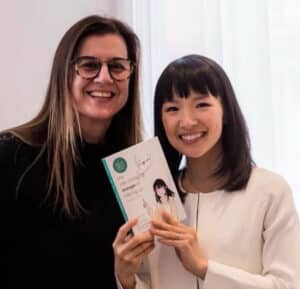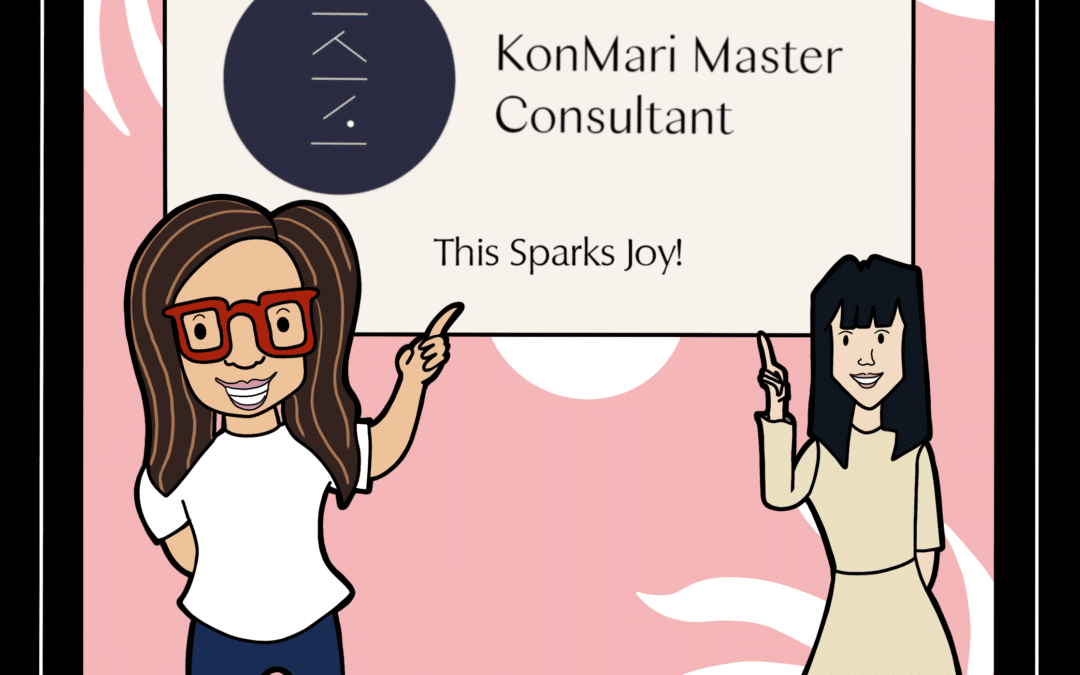As a Certified Professional Organizer in Chronic Disorganization® (CPO-CD®), I’ve worked with clients facing a range of challenges, including ADHD. ADHD presents distinct organizational difficulties, such as managing distractions, staying focused, and dealing with clutter. Many people with ADHD look to popular organizing methods for help, and one of the most well-known is Marie Kondo’s KonMari Method™.
While often associated with minimalism, Marie Kondo has clarified that the KonMari Method™ is not necessarily about owning fewer items, but about choosing what to keep based on what sparks joy. This approach encourages individuals to surround themselves with things that bring them happiness, which can be a powerful organizing principle, especially for those with ADHD. But how well does this method meet the unique needs of someone whose brain processes information differently?
Here’s a closer look at how the KonMari Method™ can benefit individuals with ADHD and where adjustments might make it even more effective, based on my experience as both a Master KonMari Consultant and a Certified Professional Organizer in Chronic Disorganization®.
Joy as a Guiding Principle
At the heart of the KonMari Method is the question, “Does this spark joy?” For individuals with ADHD, this can be a useful way to simplify decision-making. ADHD often makes it difficult to prioritize or focus on what matters, and the focus on joy can help bring clarity by directing attention to the emotional connection with possessions. This can be motivating and freeing, helping clients cut through the mental clutter.
However, identifying what sparks joy can sometimes be challenging for individuals with ADHD. Emotions can fluctuate, and what feels joyful one day may not feel the same way the next day. In these cases, it can help to incorporate additional questions like, “Does this item make my life easier?” or “Have I used this recently?” to guide decision-making and make the process more practical.
Visual and Tangible Benefits
The KonMari Method’s emphasis on decluttering and creating visually clear spaces is particularly valuable for individuals with ADHD, as it reduces cognitive overload. A clutter-free environment can make it easier to focus and manage day-to-day tasks without getting distracted by visual noise. Having fewer distractions allows for clearer thinking and helps the brain focus better on tasks at hand.
While the initial act of decluttering is often invigorating, maintaining that organization over time can be more challenging for individuals with ADHD. Routines may become difficult to stick to after the initial burst of energy fades. Although the KonMari Method™ advocates for creating permanent “homes” for items, those with ADHD may benefit from more flexible systems that can adapt to their changing needs and routines.
Organizing by Category, Not Room
Marie Kondo’s approach of organizing by category, rather than by room, provides clarity and focus—two things that can be incredibly helpful for those with ADHD. Instead of moving between rooms and potentially getting distracted, focusing on a specific category (like clothing or books) makes the task more manageable and less overwhelming.
However, for those with larger collections, tackling a category all at once may still feel daunting. Breaking these categories into smaller, more digestible chunks can help individuals with ADHD avoid overwhelm and stay on task. While this isn’t part of the original method, it’s a simple adaptation that can make the process smoother for those with ADHD.
Emotional Connection and Letting Go
A signature aspect of the KonMari Method™ is expressing gratitude for items before letting them go. This practice can provide closure, helping individuals—especially those with ADHD who may have strong emotional attachments—part with possessions in a meaningful way. It makes the process of decluttering feel less like a loss and more like a positive transition.
That said, for some individuals with ADHD who are already deeply sentimental, this emotional connection can sometimes make it harder to let go. In these cases, focusing less on the emotional aspects and more on practical considerations—such as whether the item still serves a purpose—can make the process easier.
Joy and Sustainability
At its core, the KonMari Method promotes a sustainable organizing system, where keeping only what sparks joy helps maintain an organized space. For individuals with ADHD, this focus on meaning and reducing excess is helpful, as it encourages them to prioritize what matters most. By centering the process on joy, there’s a greater emotional investment, which can make it easier to maintain the system in the long term.
However, individuals with ADHD often thrive on novelty, and what sparks joy today may not hold the same significance in the future. Given the ADHD brain’s tendency to focus on the present, it’s important to ensure that organizing systems are flexible enough to allow for regular reassessment. This ensures that the space continues to serve their changing needs and preferences.
A Flexible Approach for ADHD
The KonMari Method offers many tools that align well with the needs of individuals with ADHD—streamlining decision-making, reducing clutter, and creating visually calm spaces. However, it’s important to remember that every brain works differently, and what works for one person may need adjustments for another. Flexibility is key!
In my experience, blending the strengths of the KonMari Method with ADHD-friendly adaptations—such as breaking tasks into smaller steps, building flexibility into routines, and allowing for regular reassessment—can create a system that is not only joyful but sustainable. By focusing on what brings true happiness while maintaining a practical, adaptable system, individuals with ADHD can enjoy a more organized and functional space that supports their unique needs.
Enlisting the help of someone familiar with the KonMari method and ADHD is a great way to use “body doubling” to jumpstart the organizing process. Body doubling involves having another person present to provide accountability and focus, which can ease the overwhelm often felt with tasks like decluttering. This support person offers both practical guidance and a motivating presence, helping to create structure and making the process more manageable. Their physical presence acts as an anchor, keeping the individual on track and focused throughout the task.
If you’re interested in learning more about the KonMari Method and creating an ADHD-friendly organizing system, feel free to reach out to me at info@organizethat.ca for a personalized assessment.


